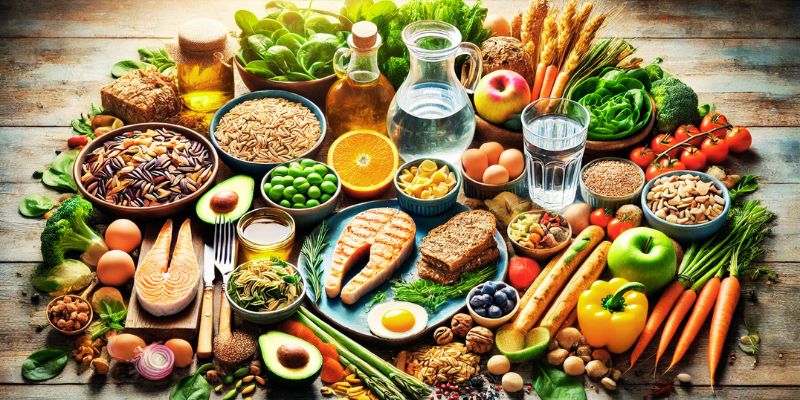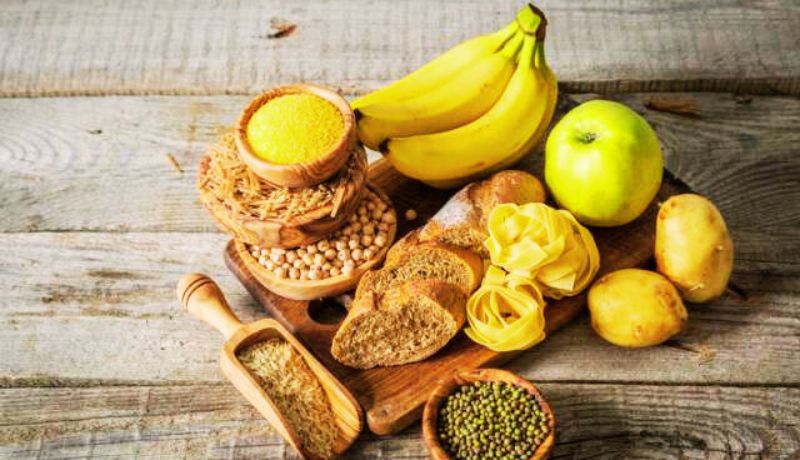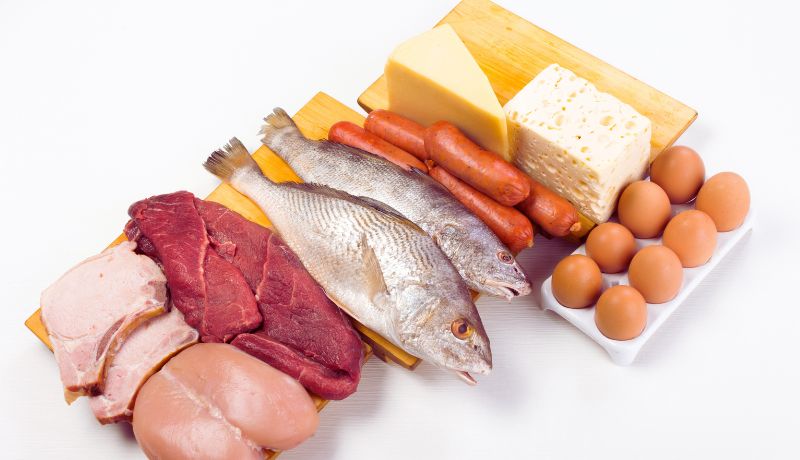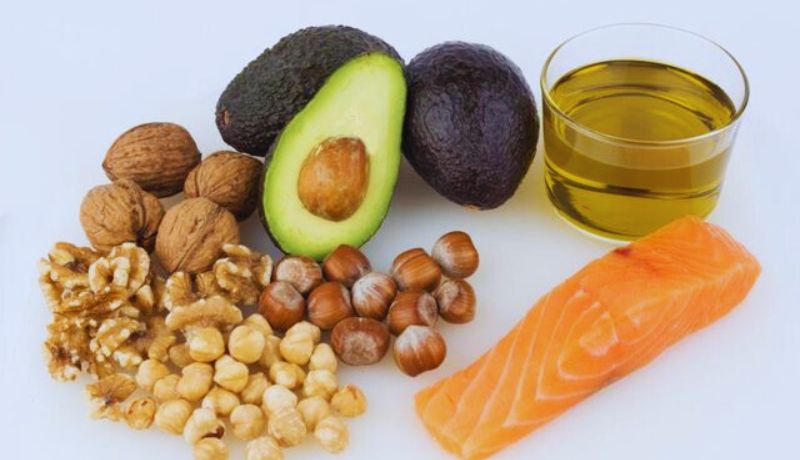
Living a healthy lifestyle begins with eating a balanced and nutritious diet.
A well-rounded diet provides your body with the essential nutrients it needs to function optimally, increase life longevity, reduce hospital visits, and decrease the likelihood of chronic diseases such as diabetes, heart disease, and obesity.
Conversely, a poor diet over time can lead to negative health outcomes, including weight gain, fatigue, and increased susceptibility to illness.
But what exactly makes up a healthy diet?
Let’s explore the essential components, backed by scientific research, to help you build a sustainable and nourishing meal plan.
The Core Components of a Healthy Diet
At its core, a healthy diet is about balance and moderation.
It involves consuming the right proportions of macronutrients (carbohydrates, proteins, and fats) alongside essential micronutrients (vitamins and minerals).
Overconsumption or deficiency of any one component can lead to adverse health effects.
Whether your goal is to lose weight, maintain a healthy weight, or simply improve your overall well-being, understanding these components is crucial.
1. Carbohydrates: The Body’s Primary Energy Source
Carbohydrates are essential macronutrients that provide the glucose your body needs for energy. Despite their bad reputation in some weight-loss circles, not all carbohydrates are created equal.
Best Sources: Opt for unprocessed or minimally processed options such as whole grains (e.g., oats, quinoa), vegetables (e.g., sweet potatoes, spinach), fruits (e.g., bananas, berries), and legumes (e.g., lentils, chickpeas).
These foods are rich in fiber, vitamins, and phytonutrients, which support digestive health and reduce the risk of chronic diseases.
Scientific Insight: A 2019 study published in The Lancet found that high fiber intake, primarily from whole grains, was associated with a reduced risk of heart disease, stroke, and type 2 diabetes.

2. Proteins: Building Blocks of Life
Proteins are vital for the growth, repair, and maintenance of your body’s tissues and organs. They’re also essential for enzyme and hormone production.
Best Sources: Include lean meats, poultry, fish, eggs, dairy, beans, nuts, seeds, soy products (e.g., tofu, edamame), and whole grains like quinoa.
For vegetarians and vegans, combining incomplete plant proteins (e.g., rice and beans) ensures you get all essential amino acids.
Scientific Insight: Research from The American Journal of Clinical Nutrition (2021) highlights that a diet rich in plant-based proteins is associated with a lower risk of cardiovascular disease compared to diets high in red or processed meats.

3. Fats: Essential for Vital Functions
Fats play a crucial role in brain function, hormone production, and nutrient absorption. However, not all fats are created equal.
Best Sources: Focus on unsaturated fats found in foods like avocados, nuts, seeds, olive oil, and fatty fish (e.g., salmon, sardines).
Limit saturated fats (found in butter, cheese, and red meat) and avoid trans fats found in processed snacks and baked goods.
Scientific Insight: A 2020 meta-analysis in Circulation showed that replacing saturated fats with unsaturated fats significantly reduces the risk of coronary heart disease.

4. Vitamins and Minerals: The Unsung Heroes
These micronutrients are crucial for immune function, bone health, and energy production. Each vitamin and mineral plays a unique role in maintaining optimal health.
Best Sources: A diet rich in colorful fruits and vegetables, whole grains, lean proteins, nuts, and seeds will help you meet your daily requirements.
If you struggle to get enough through food, consider a high-quality multivitamin supplement.
Scientific Insight: Studies indicate that diets high in fruits and vegetables reduce the risk of chronic diseases such as cancer and hypertension, as reported by the World Health Organization (WHO).

5. Water: The Cornerstone of Life
Water is essential for virtually every bodily function, from regulating temperature to transporting nutrients and eliminating waste.
Best Practice: Aim for at least 8-10 glasses (around 2-3 liters) of water per day. Adjust your intake based on activity level, climate, and individual needs.
Scientific Insight: Dehydration, even mild, can impair cognitive function and physical performance, according to a 2018 study in Frontiers in Physiology.

How to Balance Your Diet
To simplify meal planning, consider these macronutrient distribution guidelines:
- Carbohydrates: 45-65% of daily calories
- Protein: 10-35% of daily calories
- Fats: 20-35% of daily calories
Practical Tip: Use tools like MyPlate or mobile apps to track your nutrient intake and ensure you’re meeting your goals.
Fun Facts and Trivia
- Did you know that your brain relies almost exclusively on carbohydrates for energy? That’s why low-carb diets can sometimes cause brain fog!
- The human body can store enough glycogen (carbohydrate reserves) to fuel about 90 minutes of moderate exercise.
- Quinoa, often called a “superfood,” is technically a seed, not a grain, and contains all nine essential amino acids.
- Drinking water before meals has been shown to reduce calorie intake, making it a simple and effective tool for weight management.
- Avocados are unique among fruits because they contain healthy monounsaturated fats instead of carbohydrates.
Quick Tip: A colorful plate is often a nutritious plate.
Incorporate a variety of fruits and vegetables to ensure you’re getting a broad spectrum of vitamins and minerals. Think of it as “eating the rainbow.”

Conclusion: Commit to a Healthier You
Eating a healthy, balanced diet is one of the most impactful decisions you can make for your long-term health.
By incorporating a variety of nutrient-rich foods, staying hydrated, and practicing moderation, you’ll set yourself up for a vibrant, energized life.
Ready to take charge of your health? Start by planning your meals for the week. Focus on incorporating whole grains, lean proteins, healthy fats, and plenty of colorful fruits and vegetables.
Share your journey with others and inspire them to prioritize their health as well!

I love the breakdown that you have provided of 45 – 65% Carbohydrates, 10-35% Protein and 20-25% fats daily calories needed. This is a great guideline, although sometimes impossible to work out without an app of sorts.
Fats: 20-35% of daily calories.
I was just wondering, as you get older should the protein not get more and the carbs less, as we are more prone to weight gain and muscle loss?
Hi Michel,
Thank you for your insightful comment and for highlighting the macronutrient breakdown from the article.
You’re absolutely correct in noting that as we age, our nutritional needs evolve, particularly concerning protein and carbohydrate intake.
As we age, our bodies become less efficient at processing protein, leading to a condition known as anabolic resistance.
This means that older adults may require more protein to maintain muscle mass and strength. Research suggests that individuals over 60 should aim for a protein intake of about 1.0 to 1.3 grams per kilogram of body weight daily, especially when combined with resistance training.
While carbohydrates remain an essential energy source, it’s beneficial for older adults to focus on the quality of carbohydrates consumed.
Prioritizing complex carbohydrates—such as whole grains, legumes, and vegetables—can provide sustained energy and essential nutrients. Reducing intake of simple sugars and refined carbs can help manage weight and blood sugar levels.
A balanced macronutrient distribution for older adults might look like:
Protein: 30–35% of daily calories
Carbohydrates: 40–45% of daily calories
Fats: 20–30% of daily calories
This balance supports muscle maintenance, energy needs, and overall health.
It’s always advisable to consult with a healthcare professional or registered dietitian to tailor dietary needs to individual health conditions and lifestyle.
Warm regards,
Alice
Thanks for the wonderful breakdown of all of the different essential parts of the diet. Do you have any specific recommendations on keeping track of what I’m eating on a daily basis? I feel like I do a decent job, but I’ve tried a food journal before on paper and had absolutely no luck with it.
I’ve heard there are a few apps and some trackers out there, but do they handle the calorie counting for me or am I still going to have to manually punch every single item in?
Hello Craig,
Tracking your daily food intake is quite a challenge for most people who are trying to live and maintain a healthy lifestyle. What used to work before doesn’t seem to be effective today because we are living in a fast-paced society where everyone seems to be in such a hurry. Keeping a food journal may work for a couple of days but after that we’re back to square one.
The good news is there are now downloadable apps which we can use to track and monitor our daily calorie intake. But instead of enumerating them one by one, why don’t I just give you a link to the Top 5 Best Calorie Counting App.
http://heavy.com/tech/2015/04/top-best-calorie-counter-counting-diet-dieting-fitness-apps-for-iphone-android/
I believe that more people need to take their health far more seriously. I was just reading an article and heart disease is still the number 1 killer in America. Most of these cases could be eliminated by overhauling these peoples’ diets and showing them how to eat properly.
Luckily, you’ve done us all this favor and have put together this excellent article. You’ve done an excellent job of breaking down the proper components and providing there sources.
Personally, I can tell feel the difference in my overall performance when I choose to eat out vs. when I cook for myself at the house. I feel more energetic, more happy, I sleep better, I have healthier and more comfortable bowel movements, and the food I eat is prepared exactly the way I want it to be. Loads of benefits for eating a proper diet.
Also, thank you for clarifying the word ‘healthy’ because too often have I encountered people who are over-eating the foods that are good for you but they negate the benefit by eating them out of proportion.
I find that your ration breakdown is well on point as I am following a diet guideline that allows me to track the macro-nutrients that I am consuming on a daily basis.
I use the 40-30-30 (carbs, fats, proteins) ration and I’ve been able to lose at least 10 lbs a month for the past 3 months with a combination and addition of exercise.
Hey Justin,
Thanks for stopping by. You are an amazing proof that eating a healthy diet in the right proportions really does help lose weight. Although most health and fitness “gurus” advocate staying away from carbs and fats when you’re trying to lose weight or simply want to maintain a healthy weight, I still believe that the best approach is “balance.”
Some people who prefer a certain food, which is a healthy and nutritious one, might go to the extreme of over-eating it and neglect the other components of a healthy diet. Let us always keep in mind that anything consumed in excess and not utilized by the body is converted into energy and stored as fats which results to weight gain.
Preparing your own meal and eating at home is key to a healthy diet because you have full control of the kinds of foods you will consume. Although I myself eat out or go for “take-outs” once in a while I think commercially prepared foods are not the best option when you’re trying to be healthy because aside from not knowing what sort of additives have been incorporated, there’s always this question whether they are nutritious.
Great job following a diet guideline Justin. I wish you nothing but good health; remember that health is wealth.
Hey Alice,
I have been lifting weights for a year now and dieting is one of my hardest problems. This really helps break down the percentages I need to intake daily to reach my goals to staying fit. Nutrition is so important and so difficult to maintain. This post will help me in the future, thank you.
Hey there Patrick, thanks for stopping by.
There are some people who find dieting to be extremely hard compared to weight lifting. But I personally think that dieting is a lot easier especially if you love to play around in the kitchen and experiment on the best healthy foods combination. I don’t believe we have to become strict vegetarians to be healthy; we just need to know the right kinds of foods to eat and eat them in the right proportions.
I have been doing intermittent fasting for over a year and after I read your writing I was wondering that what would be the best time for taking fats?
I go to gym 3 times per week. Do you have any suggestions for me?
Hey Furkan,
Intermittent diet is becoming popular these days especially among those who want to stay fit and healthy without necessarily doing the hard work of exercising or working out. But incorporating a well-balanced diet has proven to be an effective way to stay healthy.
What’s the best time to take in fats? Salmon which is a good source of fats can be eaten for lunch along with a vegetable sandwich or at dinner with some salads. Avocado being one of the healthiest sources of unsaturated fats can be taken for snack or breakfast. I highly recommend eating it on an empty stomach to get the most out of its health benefits. Nuts for people who are always on the go is a good source of fats too.
I do not think there is a specific time when taking healthy fats. Just make sure you eat them at the right proportion.
Knowing the essential components of a healthy diet is so important to our well being. My problem though is the portions. I tend to go over board with fruits and nuts because I know of the health benefits. They are my very favorite. Whenever I gain weight, it’s because I over eat these foods I think. Could you give me a guide on nut portions? I don’t just eat a handful, but twice that, even though I know that I should not eat too much.
Anything in excess is bad. In fact even the healthy stuff can have negative effects if taken in excess because the body is programmed to utilize only certain amounts of every kind of food. Anything ingested that the body doesn’t need is either eliminated as wastes or stored and over time, are converted into fat tissues leading to weight gain, thereby increasing your risk of health problems.
I love nuts too and they are great sources of proteins and healthy fats but consuming them in excess will definitely result to weight gain. I also noticed that eating too much of nuts causes my face to become oily resulting in pimples. The recommended daily intake of nuts is about 28 grams per day which is about as much as it fits in the palm of your hand. They can be a mixture of different nuts or a handful of just one kind.
I hope this helps Carol.
Thank you for breaking down body essentials and defining their beneficial properties. While many articles focus on what to eat, your focus is on why we need to eat them.
Hi Maurice,
Knowing what kinds of foods we need to eat to stay healthy is important but I believe knowing why we should eat them is more important as it will be the driving force and motivation for us to start eating healthy and to keep us stay on track.
Thanks for coming by!
I have recently suffered a heart attack so I have had to watch what I’m eating which I’m finding pretty hard to do, have you got any tips for me so I can stop eating the junk food that I enjoy?
Hi Matthew, junk foods really taste good, don’t they? I used to fill my body with lots of junks too, like chips, fries, chocolates, cakes, ice cream, soda and all other kinds you can think of. I mean, who doesn’t enjoy junk foods? But at what expense? Becoming aware of the bad effects junk foods give to our body and health made me realize that there is actually something I can do about it. Each individual is solely responsible for taking care of their health if they want to enjoy long life.
How did I do it? First off, I do not recommend totally abstaining from junk foods because I believe that depriving yourself will certainly make you want to eat more of them. Instead, I highly recommend eating them in moderation and just once in a while. I actually tried a 100% healthy diet for almost a year and I felt really good about myself. But I also came to realize that I can indulge myself once in a while without feeling guilty about it.
If you’re really keen on eliminating junk foods, you should have an alternative. For instance, you may want to always keep a stock of several varieties of fruits that you can nibble on every time you crave for any unhealthy snacks. Baby carrots, apples, bananas and cucumber are great for snacking. I specifically like bananas because they are sweet and filling. Also don’t forget to drink lots of water because aside from being the healthiest drink, it can also suppress your hunger and cravings.